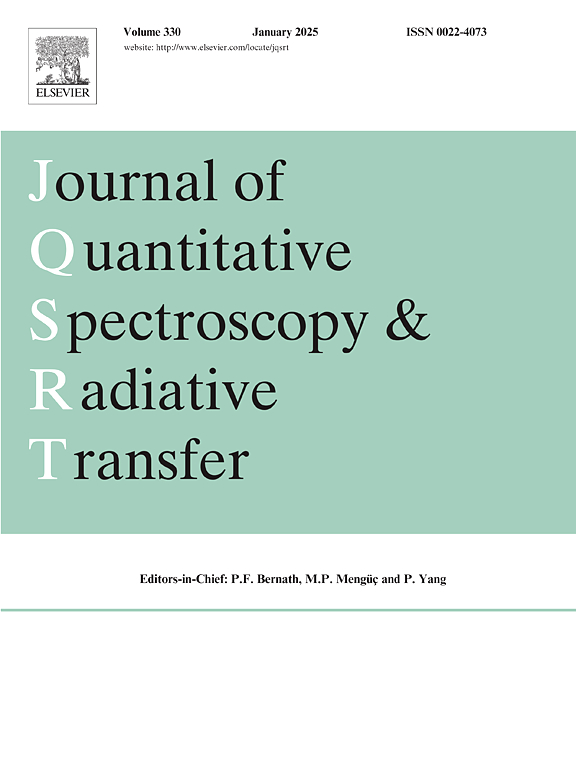不同聚集模式气溶胶散射特性的比较研究
IF 2.3
3区 物理与天体物理
Q2 OPTICS
Journal of Quantitative Spectroscopy & Radiative Transfer
Pub Date : 2025-04-23
DOI:10.1016/j.jqsrt.2025.109489
引用次数: 0
摘要
悬浮在大气中的气溶胶粒子自然聚集形成各种形态,对大气辐射传输产生重大影响。本文利用广义多粒子Mie (GMM)方法研究了粒子混合状态对链状大气气溶胶聚集体散射相函数的影响。比较了三角形(T-3)、l形(L-3)和正方形(S-4)三种构型的粉尘气溶胶粒子及其包络等效球的散射特性。该分析考虑了单个颗粒尺寸和入射波长的影响。在有效介质理论的基础上,进一步研究了城市和农村环境中T-3尘埃聚集体与其包络等效球体之间的散射特性比。结果表明,链内颗粒大小的差异决定了散射相函数的大小。在特定的尺寸参数下,T-3聚集体与其包膜等效球实现了SSA等效,而L-3和S-4形貌在一定条件下与其相应的等效球在消光、散射和SSA值上表现出光学等效。粒径参数和团聚体形态显著影响团聚体与其包络等效球的相函数比。在大小相关的前向散射范围内,环境(城市/农村)对相函数比的影响最小,这表明主要颗粒直径决定了可以忽略环境影响的角区域。这些发现有助于理解大气气溶胶聚集体对辐射传输的影响,并为大气气溶胶的反演提供理论支持。本文章由计算机程序翻译,如有差异,请以英文原文为准。
A comparative study on scattering properties of aerosols with different aggregation patterns
Aerosol particles suspended in the atmosphere naturally aggregate to form various morphologies, which significantly impact atmospheric radiation transmission. This paper investigates the impact of particle mixing states on the scattering phase function of chain-like atmospheric aerosol aggregates using the Generalised Multiparticle Mie (GMM) method. The scattering properties of dust aerosol particles arranged in triangular (T-3), L-shaped (L-3), and square (S-4) configurations are compared with their envelope-equivalent spheres. The analysis considers the impacts of individual particle size and incident wavelength. Building upon effective medium theory, this study further investigates the scattering property ratios between T-3 dust aggregates and their envelope-equivalent spheres in urban and rural environments. The results indicate that the difference in particle size within a chain determines the magnitude of scattering phase function. At specific size parameters, T-3 aggregate achieves SSA equivalence with its envelope-equivalent spheres, while L-3 and S-4 morphologies demonstrate optical equivalence, in extinction, scattering, and SSA values with their corresponding equivalent spheres under certain conditions. Size parameter and aggregation morphology significantly influence the phase function ratios between aggregates and their envelope-equivalent spheres. Environmental (urban/rural) influences on the phase function ratio are minimal within size-dependent forward scattering ranges, suggesting that primary particle diameter determines the angular region where environmental effects can be neglected. These findings contribute to understanding the impact of atmospheric aerosol aggregates on radiation transmission and provide theoretical support for the retrieval of atmospheric aerosols.
求助全文
通过发布文献求助,成功后即可免费获取论文全文。
去求助
来源期刊
CiteScore
5.30
自引率
21.70%
发文量
273
审稿时长
58 days
期刊介绍:
Papers with the following subject areas are suitable for publication in the Journal of Quantitative Spectroscopy and Radiative Transfer:
- Theoretical and experimental aspects of the spectra of atoms, molecules, ions, and plasmas.
- Spectral lineshape studies including models and computational algorithms.
- Atmospheric spectroscopy.
- Theoretical and experimental aspects of light scattering.
- Application of light scattering in particle characterization and remote sensing.
- Application of light scattering in biological sciences and medicine.
- Radiative transfer in absorbing, emitting, and scattering media.
- Radiative transfer in stochastic media.

 求助内容:
求助内容: 应助结果提醒方式:
应助结果提醒方式:


